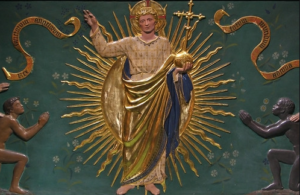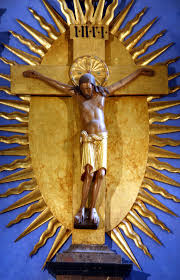Christ as the Sun of Justice, Southwark Cathedral
Mount Calvary Church
A Roman Catholic Parish
The Personal Ordinariate of S. Peter
Eutaw Street and Madison Avenue
Baltimore, Maryland
Trinity XXII
Rev. Albert Scharbach, Pastor
Dr. Allen Buskirk, Choirmaster
Midori Ataka, Organist
Sunday, November 17, 2019
8:00 A.M. Said Mass
10:00 A.M. Sung Mass
Brunch to follow in the undercroft
_______________
Prelude
Praise God from Whom All Blessings Flow, arr. Johann Pachelbel
Postlude
Helmsley, arranged by Charles Callahan
_______________
Anthems
Vigilate, William Byrd (1540-1623)
Vigilate, nescitis enim quando dominus domus veniat, sero, an media nocte, an gallicantu, an mane. Vigilate ergo, ne cum venerit repente, inveniat vos dormientes. Quod autem dico vobis, omnibus dico: vigilate.
Watch ye therefore (for you know not when the lord of the house cometh, at even, or at midnight, or at the cock crowing, or in the morning): Watch therefore, lest coming on a sudden, he find you sleeping. And what I say to you, I say to all: Watch.
Vigilate is an early work by William Byrd (1540-1623) published in his Cantiones Sacrae of 1589. It takes its text from Mark 13 where Christ exhorts his disciples to watch and prepare for the coming of the Lord. This work is unusual for its text painting characteristic of the secular, Italian madrigal style. Listen, for example, for “an galli cantu” (at the cock-crow), where the voices imitate the rooster’s crow with leaps and rapid runs. The phrase “inveniat vos dormientes” is set in a long, slow double canon reminiscent of sleepy disciples. And at “repente” (suddenly), a frantic burst of fast rhythms jumps out of the texture.
__________
Audivi vocem de caelo, Thomas Tallis (1510-1585)
Audivi vocem de caelo venientem: venite omnes virgines sapientissime; oleum recondite in vasis vestris dum sponsus advenerit. Media nocte clamor factus est: ecce sponsus venit.
I heard a voice coming from heaven: come all wisest virgins; fill your vessels with oil, for the bridegroom is coming. In the middle of the night there was a cry: behold the bridegroom comes.
The motet Audivi vocem de caelo by Thomas Tallis (1505-1585) offers a completely different take on the same theme, here portrayed with language from the parable of the wise and foolish virgins awaiting the coming of the bridegroom. This motet makes use of the Sarum Rite plainchant (the ancient liturgy of the English church that was finally abandoned in 1559) and several clues point to a very early date of composition prior to Mary’s reign. English composers continued writing in the late Medieval style in the early 16th century long after composers on the continent had abandoned it; this motet is an example of that trend, with its avoidance of imitation between voices and its uninflected modal harmonies.
_________________
Hymns
The king shall come when morning dawns (MORNING SONG) is by the Scottish Free Church minister John Brownlie (1857–1925). He translated many Eastern hymns, and this hymn bears the impress of Eastern theology. Infused with the imagery of morning light typical of early Greek hymnody, hymn stirs hope in the hearts of all who look forward to the return of Christ. It is a confession of faith in the sure return of our Lord; his coming again will occur in a blaze of glory, which will far surpass his earthly death and resurrection. The text concludes with a paraphrase of the ancient prayer of the church-“Maranatha,” or “Lord, come quickly” (Rev. 22:20). We should not fear, but yearn for the coming of the One we love. MORNING SONG is a folk tune that has some resemblance to the traditional English tune for “Old King Cole.” The tune appeared anonymously in Part II of John Wyeth’s Repository of Sacred Music (1813).
The Lord will come and not be slow (YORK) is a cento by John Milton (1608-1674) of words from Psalms 82, 85, 86. The tune YORK is an old Scottish melody.
Lo, He comes with clouds descending is by John Cennick (1718–1755) and Charles Wesley (1707–1788). The content of the text and particularly the title are derived from Rev 1:7, which tells of the Second Coming. As the liturgical year approaches the coming of Christ at the Nativity, we keep in mind His coming that we await, when He shall come as Judge to make known the truth about the entire history of the human race and indeed of the universe. How will we respond when He shows us the truth about our lives and how they are part of His whole plan of salvation? With wailing or exultation?
The tune HELMSLEY is by Thomas Olivers (1725–1799), who heard the tune whistled in the street and derived his melody from music, a sequence is a short melody that is repeated at a different pitch level. In this case (“Alleluia! alleluia! alleluia!”), the melody is repeated once a step lower and then a step higher. Such repetition intensifies the text that is repeated.
_____________________________
The Sun of Justice
The first reading today is from Malachi, indeed the very last prophetic words of the Old Testament:
1 “For behold, the day is coming, burning like an oven, when all the arrogant and all evildoers will be stubble. The day that is coming shall set them ablaze, says the LORD of hosts, so that it will leave them neither root nor branch. 2 But for you who fear my name, the sun of righteousness shall rise with healing in its wings. You shall go out leaping like calves from the stall. 3 And you shall tread down the wicked, for they will be ashes under the soles of your feet, on the day when I act, says the LORD of hosts.
4“Remember the law of my servant Moses, the statutes and rules that I commanded him at Horeb for all Israel.
5“Behold, I will send you Elijah the prophet before the great and awesome day of the LORD comes. 6 And he will turn the hearts of fathers to their children and the hearts of children to their fathers, lest I come and strike the land with a decree of utter destruction.”
The image in this blog is a bas relief by Sir Ninian Comper in the Missionary Chapel of Southwark Cathedral. Christ stands in front of the sun with its healing rays. He holds the globe of the world, because he is the light of all nations (Isaiah); kneeling on either side of him are a figures from mission lands.
From the blog UNAM SANCTAM CATHOLICAM:
Wherever this glory spreads also goes the justice and universal dominion of God. This is the meaning of one of the most famous passages in Isaiah – and one which no one familiar with Handel’s Messiah can ever read without humming:
Every valley shall be raised up, every mountain and hill made low; the rough ground shall become level, the rugged places a plain. And the glory of the Lord shall be revealed, and all flesh will see it together. For the mouth of the Lord has spoken (Is. 40:4-5)
It is beyond the scope of this article to explain the liturgical, historical, and theological reasons for worship facing east; but we can note that, symbolically, it is very fitting. The Messiah is likened to the sun, which rises in the east. This ties in to a very ancient Christian tradition that when Christ returns, He will return from the east. And this is not based solely on an allegorical connection between Jesus and the sun; Christ Himself says in the Gospel of Matthew, “For as lightning comes out of the east, and appears even into the west: so shall the coming of the Son of man be” (Matt. 24:27).
Now, Christ certainly may not be teaching that He will literally appear in the east first; but symbolically, it makes sense to associate His coming with the east. The sun, our Lord’s symbol, rises in the east. Jesus says His coming will be like lightning that comes from the east. In classical antiquity, the east signified brightness and daylight while the west signified darkness. In English etymology, the word east means towards dawn; daybreak, while the word west means “evening, night.” The same connotation exists in Greek and Latin.
Thus, it makes sense that the liturgy should be oriented towards the east, for from here – symbolically at least – the faithful may expect the return of the Lord Jesus Christ, and the ad orientem posture demonstrates the Church’s faith in Christ’s return, professed in the Creed when we say, “He will come again in glory to judge the living and the dead.”
May the Sun of Justice rise upon us. As we prepare to enter Advent, may we recall the words of the traditional hymn, Hark, the Herald Angels Sing,
Hail the Sun of Righteousness!
Light and life to all He brings,
Ris’n with healing in His wings.


I very much love that you share the music which is integral to your liturgy each week at Mount Calvary. Thank you for the recordings, including the hymns. I am an at-large member of the Ordinariate in Canada , but not close to an Ordinariate Church. What you provide here is balm for my soul. Please, please continue to do it. I pray that you have spread the word throughout the Ordinariate. Thank you thee times over. I am very grateful to you.
Sincerely In Christ Jesus,
Larry C. Lewis
London Ontario Canada
Thank you for posting the music each week for the Holy Mass at Mount Calvary. In particular, I very much appreciate the recordings, the texts with translations, not least the hymns with historical notes. I am a member of the Ordinariate, at-large, too far to attend an Ordinariate Church. What you provide here is balm for the soul for people like me.I can’t praise what you are doing enough. Thank you three times over. I pray that you have
put out word throughout the Ordinariate what you are doing.
Sincerely In Christ Jesus,
Larry C. Lewis
London Ontario Canada
Many thanks for the encouragement. I never know who is reading the blog or what they get out of it.